This might be controversial to say but depending on how you’re cooking, I’m willing to bet most people wouldn’t be able to make a distinction between brands of pellets.
On a pellet smoker you typically have “modes” that allow for temperature swing (typically between 5 -15 degree difference) for more smoke output.
Since pellet grills burn so efficiently – “best” is whatever is cheapest, in my opinion.
1. Lumber Jack Pellets
Without a doubt, Lumber Jack is my favorite brand of pellets for smoking.
This is for 2 reasons:
- Cost
- Quality
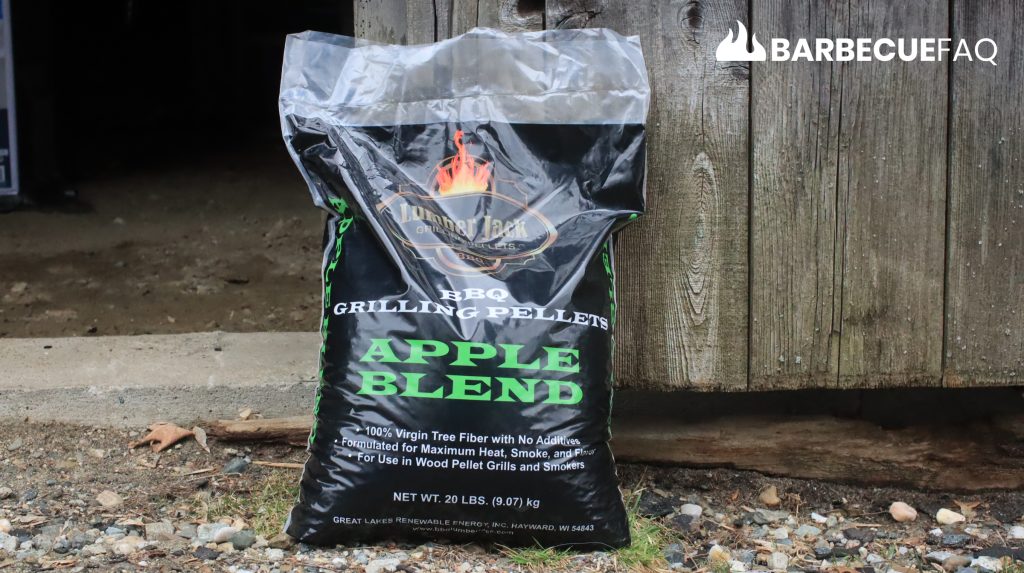
Lumber Jack are a brand that’s relatively accessible to me via my local Runnings (home improvement/outdoor/farming store).
Regardless of the flavor of the pellet, each bag costs $9.99/20 lbs.
Update 2024: This article was published 3 years ago; These pellets are still $9.99/20 lb bag.
The 2 most common I find are the “Competition blend” – A mixture of my favorite woods: Cherry, Hickory, and Maple – or their 100% hickory wood pellets.
Of the decent brands out there, you’d be SUPER hard pressed to find something more affordable.
In terms of “quality”, I’m mainly referring to the composition of pellet.
The composition of the pellet affects the flavor output (which is minimal) and the amount of cleanup you have to do.
Unlike other brands, whatever hardwood is mentioned on the bag as 100% is that hardwood. You’re not paying for a filler or base wood like Alder or Oak, you’re getting full flavor from that specific variety – Meaning, hickory is hickory and cherry is cherry, etc.
The only varieties that use Red Oak as a base are the pellets labeled as blends – ie, the competition blend, pecan blend, apple blend, etc.

Lumber Jack is a round log plant which means they harvest actual trees and chip them up as green chips resulting in full flavor.
Due to the above reasoning, they leave the bark on the primary wood in blends (so more of that woods flavor comes through) and remove the bark from the secondary wood.
For this reason, ash content in blends is lower since they have less bark than the 100% varieties (not de-barked).
2. BBQer’s Delight
On Pellet Head/BBQ forums, BBQer’s Delight is one of the more popular brands.
While not much is said on their official website in regards to who owns and runs the company, BBQer’s Delight is run by Candy Weaver and is based out of Pine Bluff, Arkansas.
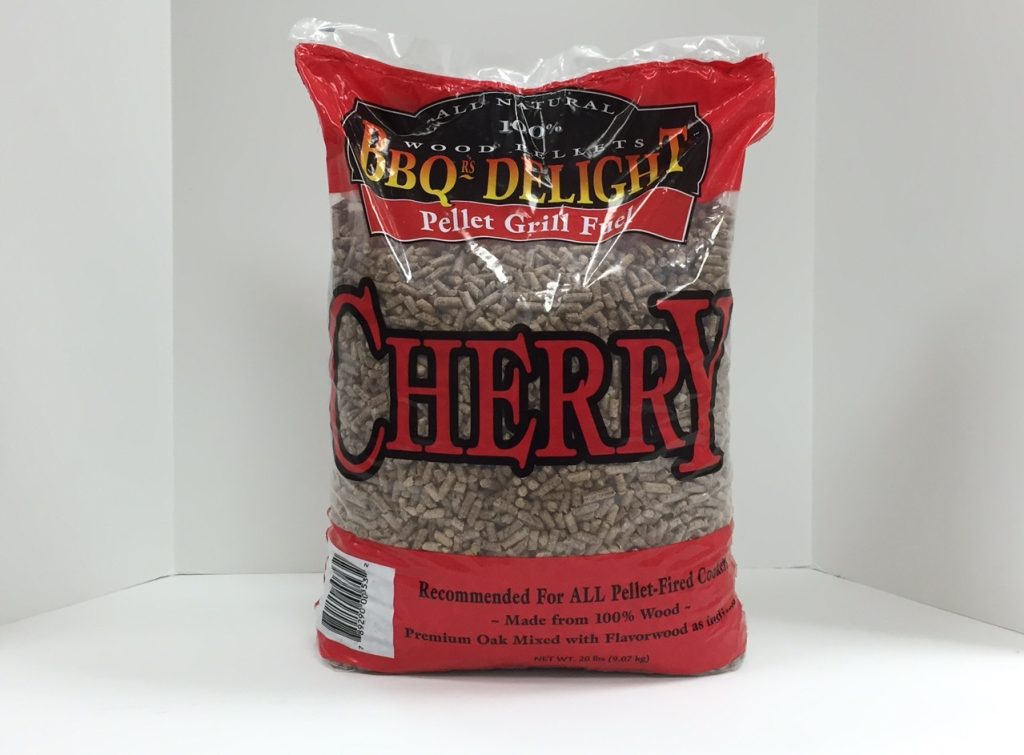
If you’re not familiar with Candy, she is one of the most respected folks in BBQ; She was on the board of directors for the Kansas City Barbecue Society (KCBS) and has even served as President of the KCBS.
As you might expect, someone this invested into barbecue knows and understands the importance of a good product.
Candy’s opinion on pellets has also influenced how they’re manufactured and what goes into their production.
- BBQer’s delight uses either de-barked red or white oak as a base.
A lot of resources will note this is a “bad” thing as the wood being used isn’t entirely that species of hardwood. However, the point in using the oak as a base is to ensure a consistent, high BTU fuel source.
Candy notes that their blends are roughly 2/3 oak and 1/3 flavor wood. Meaning if you bought their “Cherry” pellets, it would be 2/3 oak sawdust as a base and 1/3 cherry wood for flavor.
There are no chemicals/flavoring oils added to the wood to impart flavor, just 100% natural wood.
3. B & B Wood Pellets
It’s been said that B&B pellets are essentially re-branded BBQer’s Delight – Maybe that’s why I like them so much?
I’m not sure where this rumor stems from but I’m not one to feed into the regurgitating non-sense that is found on barbecue forums. Rather, I like to hear it straight from the horses mouth.
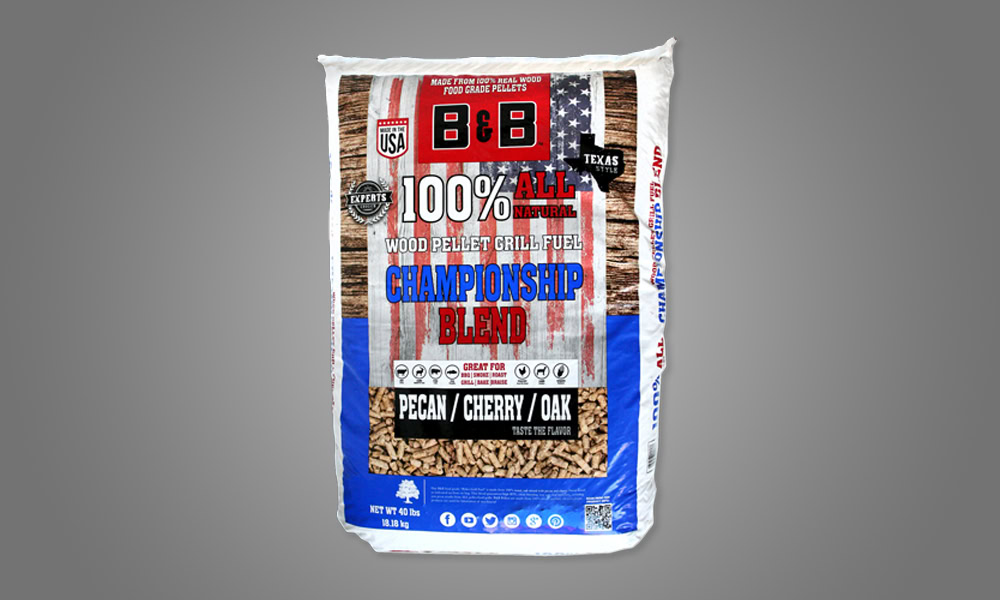
The following is a response to an email I sent to B&B.
They responded within 24 hours and were forthcoming with information.
To highlight their response: “B&B pellets are not rebranded BBQ’ers delight products. The pellet mill uses our materials and our formula to make our pellets.”
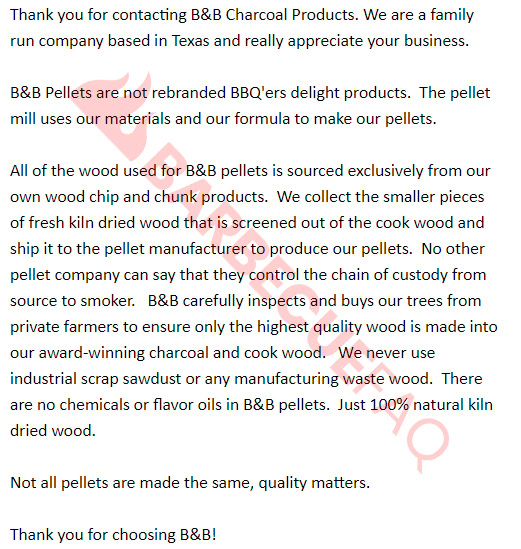
Ater additional digging on a thread of Candy Weaver’s (Owner of BBQer’s Delight) a number of folks note that BBQer’s Delight is the manufacturer of the pellets themselves.
However, B&B notes they supply the pellet mill with their materials. Candy doesn’t outright state one way or the other, she does however note:
“B&B Champ Blend is my contest mix in one 40# bag. Candy’s Contest Mix is one bag of cherry and one of pecan.”
CandySueQ
I’ll be honest, I don’t care one way or the other who makes the pellets, as long as the output is good; Which it is.
On the off-chance that you have an Academy Sports store near you, you can get B&B pellets much cheaper – $9.99/20 lbs – they’re now $19.99 for a 40 lb bag.
I tested their their pellets after watching a video by Jason over at TrendKillr Grill Craft. Overall I was pretty happy with the output.

To echo some of Jason’s comments:
- There is minimal ash build-up,
- strong flavors,
- and I also noticed pellet useage was way-down on my Grilla Grill.
My Silverbac is already fairly insulated and combined with these pellets, maintaining temperatures seemed easier – Jason notes this may be due to the the Oak base – which is something Candy noted above in terms of why they use red/white oak as the base wood, go figure.
Something my Father and I both noticed was that these pellets ignited super fast, a process that normally takes 8-10 minutes, took less than 5.
4. CookinPellets
Of all the pellet brands that are “touted” by most resources online, CookinPellets is the most common.
They’re most known for being one of the only pellet brands that use only the hardwoods labeled on their product, at least that’s their “shtick.”
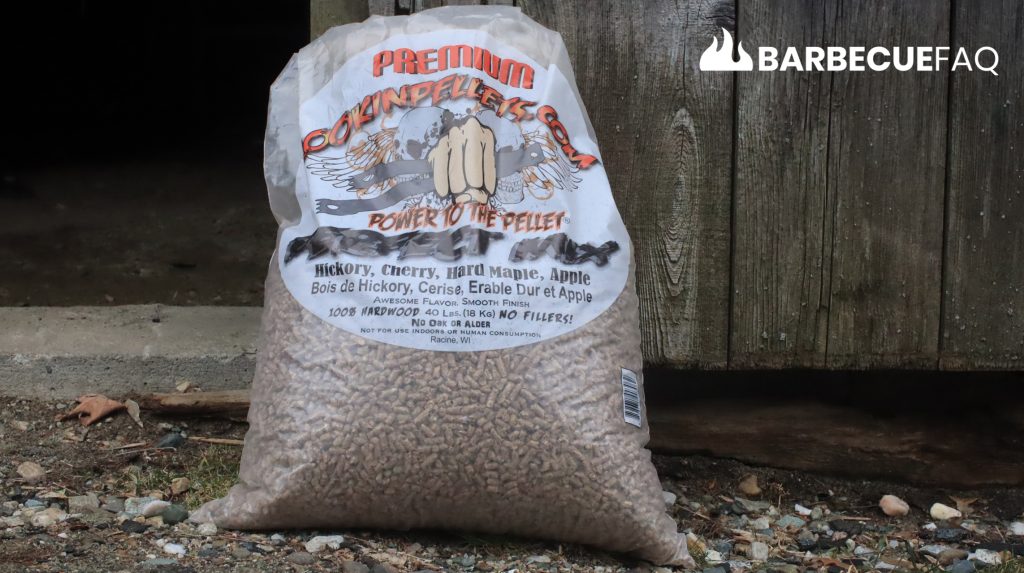
For example, their Perfect Mix Pellets use Hickory, Cherry, Hard Maple, and Apple – the pellets only consist of those woods and do not use an alder or oak base.
They also only use heart woods (center of the log) and no bark.
Similar to BBQer’s Delight, it’s somewhat hard to determine who even owns the brand. However, upon doing enough digging you’re able to find that Chris “Pellet Guy” Becker owns CookinPellets.
Chris created CookinPellets because he wasn’t able to find pellets that were 100% the hardwood listed.
I’ve bought several bags over the years, and so has my father. These are the main downsides we always have found:
- As far as I know, they’re only available online.
- There is a definite amount of excess ash
- Smoke flavor is super mild, at least for the Perfect Mix.
- The price – they’re expensive and there’s no dancing around that
- The pellets appeared to be longer-ish
Temperatures were stable, and you get exactly what’s stated on the package.
A few reviewers have noted some quality control issues in the past; Namely foreign contaminants. However, of the times I’ve used these pellets I’ve never had these experiences. I’m unsure if this was an isolated incident as only a few reviewers had this issue.
5. Insert Name Brand Manufacturer Here – Pit Boss, Grilla, Traeger, Louisiana, etc.
The reason I sort of wrapped all of these into their own category has nothing to do with their quality – or to even imply they’re the same quality.
Simply put, Pellet grill Manufacturers want to keep your business at all points of your grills useful life.
Meaning you may spend $500 – $800 $700-$1200+ these days on a pellet grill up-front but they also get you on the back-end through your purchase of their pellets – which is several thousands of dollars assuming a useful life of like 5 years.

Whenever I go to buy pellets, if they don’t have the brands I’m after like LumberJack, or a sale on a random brand (below $10/20 lbs), I opt to bite the bullet and just buy a name brand.
Where I’m from, the most popular at retail are Traeger and Pit Boss. However, I have seen Louisiana Grills a few times at my local Home Depot.
Update 4/2025: Found 40 lb bags of Pit Boss Pellets at my local Walmart for $9 a bag.
Note: In almost ALL cases, these pellets cost more than the brands above at retail, that’s just my experience.
Where-as online these brands tend to be cheaper as they have stock available at warehouses that are in proximity to your locale – cuts down on shipping costs.
I’ve had mixed experiences with these brands too.
A number of resources and reviews will state they had a significant amount of ash production. You can actually visually see this in the bag itself as the bags will tend to have a lot of pellet dust.
It’s hard to say if it’s just a case of getting a “bad” bag or something along those lines as my own experiences are mixed.
Here’s a picture of what I’m referring to; This is from the bottom of the bag of Traeger Pecan wood pellets:

Often what you’ll see regurgitated online is that these brands use Alder or Oak and then treat the wood with an oil in order to output a desired flavor.
A brand that has allegedly done this is Traeger.
A person even filed a class-action lawsuit against them that was dismissed. However, Traeger notes they use 100% virgin hardwood and a soybean (food-grade) oil to aid in the manufacturing process.
I’m not one to act elitist and state a brand is bad based on hearsay. I can only go based on what the brand details. Simply put, what they write on their website is either true or an outright lie.
There are patents that can be referenced on this information. For instance, Traeger’s Patent implies they use a wood oil:
“The present invention relates to flavored wood pellets and a method of making flavored wood pellets. The wood pellets of this invention include wood particles, lubricant, and wood oil. Another aspect of the invention is a method that includes mixing wood particles with lubricant and wood oil, heating the mixture, and forming the mixture into pellets.”
However, when watching a video from their official YouTube, the mention of “wood oil” is entirely left out. Where-as “mill-wood shavings” and “soybean oil” are mentioned (also in the patent); The same could be said for the base hardwoods: alder and oak.
Based on the information above, I’ll let you be the judge so-to-speak. I’m not here to state one thing or the other, just to report what I’ve found on this topic as it’s something a lot of people in the Pellet world discuss.
Another thing to keep in mind is that while some of these companies have their own Mill like Pit Boss and Traeger a brand like Grilla Grills does not (at least that I’m aware of).
I will still buy Traeger, Pit Boss, or insert brand name here pellets when I’m in a bind.
However, this leads me to another common question:
Do You Have to Use the Same Name Brand Pellets?
No.
Just because you own a Pit Boss Pellet Grill does not mean you have to use Pit Boss Brand pellets. The same goes for if you own a Traeger, Grilla Grill, Camp Chef, etc.
I remember hearing in the past that some brands offered conditional warranties if you used a different brand’s pellets. This practice is illegal, and you should avoid brands with conditional warranty coverage.
These days, most pellet grill brands will state that their pellet grill is “only approved/designed for burning food-grade barbecue wood pellets.”
Can’t I Just Use “Heating” Wood Pellets?
No.
Wood pellets used for smoking meat are compressed hardwoods that are extruded into a uniform size and consistency. These pellets are designed for both heat (BTU output) and smoke flavor.
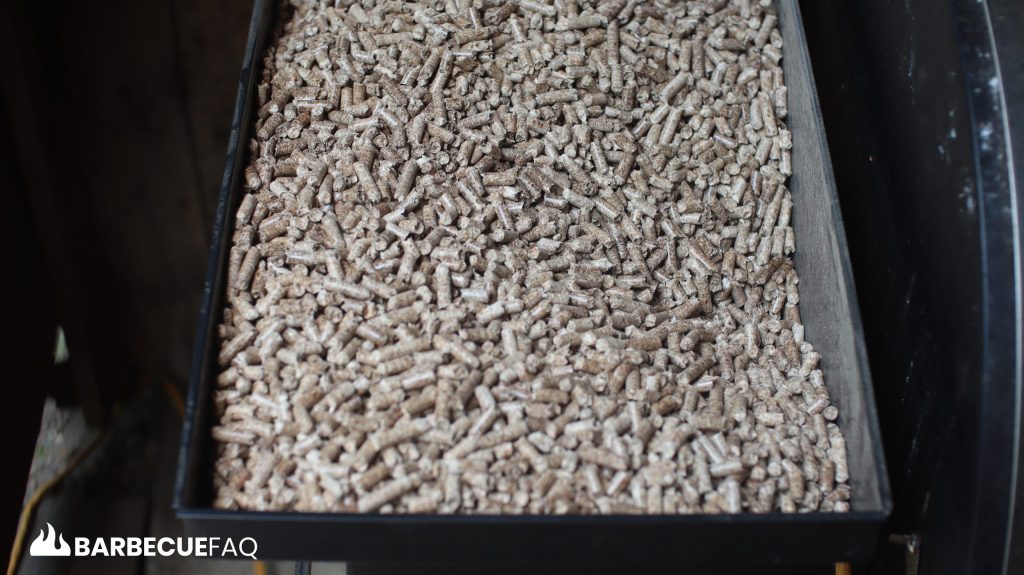
Pellets used for smoking foodstuff are hardwoods – Hickory, Oak, Pecan, Maple, Cherry, Apple, Mesquite, as well as a few others.
Learn More: The Different Types of Wood for Smoking Meat
Pellets that are used to heat homes are often made of softwoods, hardwoods, even other forest materials/scrap – whatever is plentiful and able to offer sufficient BTU to heat a home.
Home heating systems are also closed in that the gases and by-products are exhausted through a chimney; In a Pellet smoker, these gases directly interact with your food.
In my opinion, while you technically could use heating pellets, that puts a lot of trust into that manufacturer. I’d rather work with someone who sells “cooking” pellets or even uses a gimmicky term like “food-grade.”
Word of Caution on Shipping Pellets if You Buy Online from this List
Just to be blunt, temper your expectations for shipping.
You’re taking a bag of 20-40 lb pellets, they’re being put into a previously used box and then shipped and handled by several different people.
A number of reviewers and people will note that the “bag was torn” or “damaged during shipping.”
Why does that automatically drop their “rating”? Seems petty to me, especially when the issue isn’t the company itself, rather the people fulfilling the shipment.


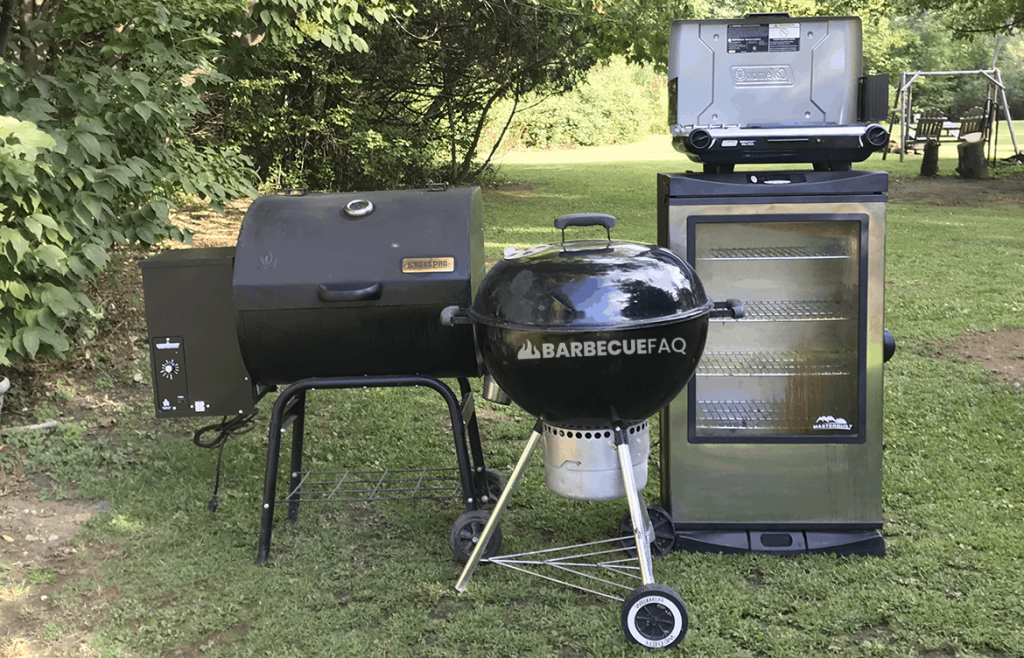

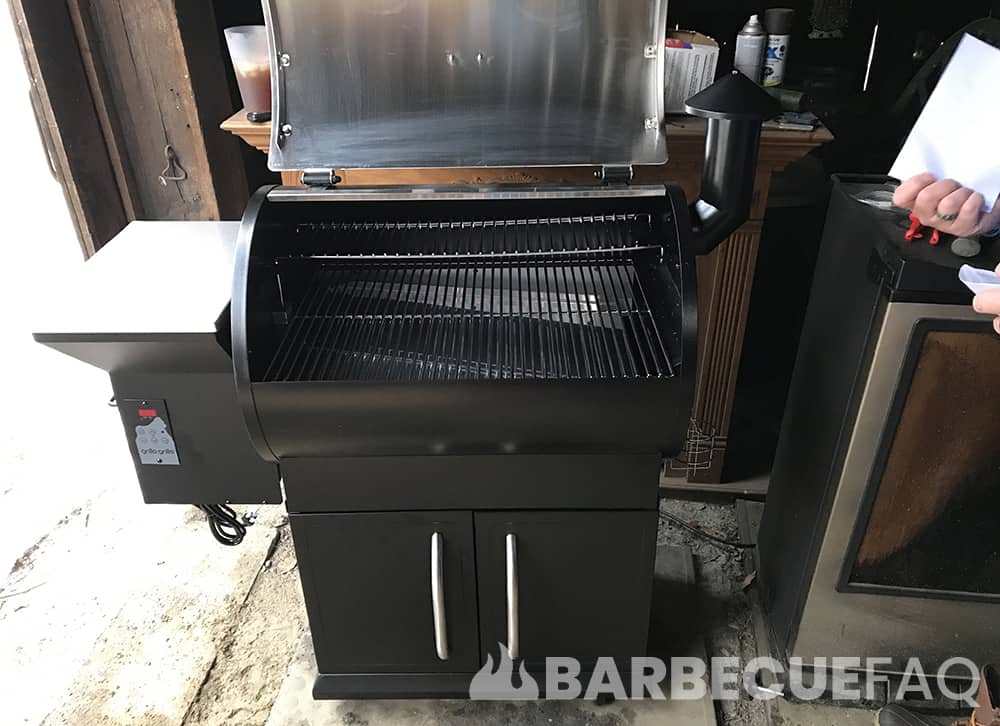
13 comments
Nathan Dekenipp
I’m sure it probably makes a difference where you live. I’ve been using B&B pellets for years now and I’ve always gotten a 40lb bag for $19.99 at Academy. I live in texas so maybe that changes things. 🤷🏼♂️
Dylan Clay
Hey there!
So this article was originally posted in 2018 and I try to update as frequently as I can – that price has changed on Academy like 4 times since I posted it – hence the cross out – and now the new price is $19.99 for 40 lbs, which is really solid.
I’m actually from NH and have used (and loved) B&B pellets 1 time.
Cheers for the comment though Nathan, just updated the article with that new pricing.
-Dylan
Aaron
I have the GE Profile indoor smoker. They recommend Kona wood pellets. Have you ever used them?
Dylan Clay
Hey Aaron,
I have not.
I’ve actually never heard of the brand but I’ll be sure to note them down and buy a few.
I will say though, their pricing is abnormally high from what I can see.
8 lbs for $40 and then shipping is ~$7 where I live so $47 for 8 lbs of pellets.
Normally, I pay $9 for 20 lbs of Lumberjack.
Personally, I stick to whatever is local to me and whatever is cheap – right now that’s still Lumberjack and as of recent, Bear Mountain.
Rick
I also have a GE Profile Indoor Smoker. I used up the Kona brand pellets that came with it, then switched to Knotty Wood pellets. I currently have Plum and Almond and love them both.
Tammy F.
Appreciate your thoughts on the food cooking pellets. We recently have dealt with unexpected smoke and condensation in our pellet hopper… for 1.5 yrs no issues until recently… unsure if a bad bag of Bear Mountain pellets???? It has happened 2x now… which I have to remove remaining pellets and clean auger throughly due to dampnesses created during cooking . I reside in a dry climate and store pellets in a sealed container/dry.
Dylan Clay
Hey Tammy – that’s a super strange scenario and one I’ve personally never experienced. Where I’m from I have tons of moisture swing (New Hampshire) and I’ve now used Bear Mountain pellets dozens of time and I’ll actually be adding them to the list above.
I’m curious, what pellet grill do you have? How would you describe the pellets when you clear them from the auger, are they solidified into a solid mass (ie, the pellets got wet and then formed a concrete), or are the pellets just jamming because of their size?
-Dylan Clay
Weldon Grable
I commend you for researching. Cooking pellet.com products are available in retail situations because I sell them. I’ve been selling pellet grills for over 10 yrs and cook on them daily. All the talk about ash always surprises me. For the most part if you spend more money (if you can) the ash problems go away. You won’t have ash issues with Top end Traeger’s like Timberlines and Ironwoods. Nor with Yoders or Memphis grills. Louisiana grills and Pitboss on the other hand produce plenty. Usually this is on purpose to produce smoke. I currently am a platinum Traeger dealer, I also sell Yoders, Memphis grills, Louisiana grills and some Pitboss. I have sold other brands in the past. My experience with 2/3 oak 1/3 flavor wood pellets is that customers can’t tell the difference from bag to bag; One third flavor wood isn’t enough. That’s why my go to are cookingpellets and lumberjack. I have a couple flavors of Traeger pellets on hand to satisfy people loyal to the brand.
Dylan Clay
Appreciate your comment Weldon.
Jill
Hey Dylan,
Just wanted to say Thank You for your very helpful guide.
We just purchased our first Pellet Grill for Father’s Day
and I was looking for some honest advice. I appreciate it!
Have a great Summer 🙂
Dylan Clay
Happy to help Jill! Enjoy the new pellet grill.
-Dylan
Wade Vande Vooren
Check out knotty wood pellets
Dylan Clay
Hey Wade,
Knotty Wood pellets are on my list actually. I’m not super big on buying pellets online and basically stick to what I can source locally but I’ve heard too many good things about them that it warrants putting them to the test; The same could be said for Bear Mountain, both are on my list to buy and test on a number of cooks.
Cheers for the comment.